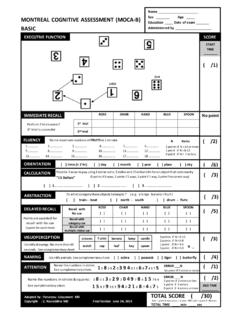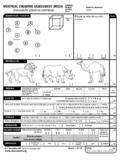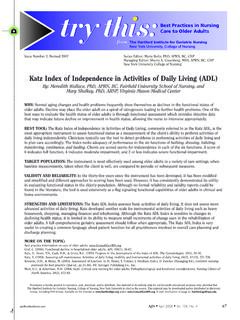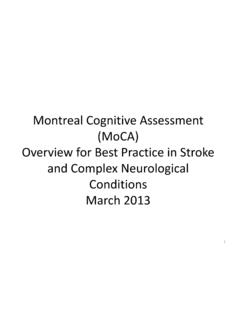Transcription of Montreal Cognitive Assessment Basic (MoCA-B ...
1 Adapted by: Parunyou Julayanont MD Copyright: Z. Nasreddine MD moca -B Version June 4, 2014 Montreal Cognitive Assessment Basic ( moca -B) Administration and Scoring Instructions The Montreal Cognitive Assessment ( moca ) was designed as a rapid screening instrument for mild Cognitive impairment. The Montreal Cognitive Assessment Basic ( moca -B) was developed to facilitate the detection of mild Cognitive impairment in illiterate and lower educated subjects. The moca -B assesses similar Cognitive domains as the original moca : executive functions, language, orientation, calculations, conceptual thinking, memory, visuoperception, attention and concentration.
2 Time to administer the moca -B is approximately 15 minutes. It is scored on 30 points. All instructions may be repeated once except if otherwise specified. START TIMING: The examiner writes the time (hour-minutes-seconds) in the right-hand column of the test sheet prior to administrating the first task (Executive Functions). 1. Executive Function (Alternating Trail Making) The task is upside down to reduce manipulation of the test sheet; the examiner simply slides the test sheet across the table to the subject (the numbers should be upright for the subject). Administration: The examiner gives the following instructions: Please draw a line alternating between a square with a number and a square with dots in increasing order.
3 Begin here [point to the square with the number 1] and draw a line from the square with the number 1 to the square with one dot [point to the square with one dot]. Then draw a line to the square with the number 2 [point to the square with number 2] then to the square with two dots [point to the square with two dots] and so on. End here [point to the square with six dots]. Scoring: The correct pattern is as follows: 1 point is allocated if the subject successfully draws the correct pattern on the first attempt without any errors or self-corrections. No points are allocated if the subject draws an incorrect pattern or makes an error, even if it is immediately self-corrected.
4 2. Immediate Recall Administration: The examiner gives the following instructions: This is a memory test. I am going to read a list of words that you will have to remember now and later on. Listen carefully. When I am through, tell me as many words as you can remember. It doesn t matter in what order you Adapted by: Parunyou Julayanont MD Copyright: Z. Nasreddine MD moca -B Version June 4, 2014 say them. The examiner reads the list of five words at a rate of one word per second. A checkmark is made in the allocated space for each word the subject recalls on the first trial.
5 When the subject indicates that (s)he has finished (has recalled all words or can recall no more words), the examiner gives the following instructions: I am going to read the same list a second time. When I am through, tell me as many words as you can remember, including words you said the first time. The examiner reads the list a second time and makes a checkmark in the allocated space for each word the subject recalls on the second trial. At the end of the second trial, the examiner informs the subject that (s)he will be asked to recall these words again by saying: Try to remember these words as I will ask you to recall these again at the end of the test.
6 Scoring: No points are given for Trials One and Two. 3. Fluency Administration: The examiner gives the following instructions: I want you to name as many FRUITS as you can think of. I will tell you to stop after one minute. Go ahead. [Begin timing. After 60 seconds say:] Stop. The examiner records all the words to ensure that repeated words are not scored. Scoring: 2 points are allocated if the subject generates 13 words or more. 1 point is allocated if the subject generates 8-12 words. No points are allocated if the subject generates 7 words or less. 4. Orientation Administration: The examiner gives the following instructions: Without looking at your watch, tell me approximately what time it is.
7 The examiner then says: Now, tell me what day of the week it is and what month and year it is. Tell me the name of this place and which city we are in. Scoring: 1 point is allocated for each correct answer. For the time, an answer within two hours of the actual time is accepted. The subject must give the exact day of the week, month, year, place (name of hospital, clinic, office) and city. 5. Calculation Administration: The examiner gives the following instructions: "Pretend you have several 1 dollar coins/bills and 5 and 10 dollar bills in your pocket. Please provide me with the maximum number of combinations to pay for an item that costs 13 dollars.
8 You cannot ask for change." If the subject provides a combination that requires change, provide the following prompt once: Are there any other combinations? The examiner records the subject s answers in the space provided. Adapted by: Parunyou Julayanont MD Copyright: Z. Nasreddine MD moca -B Version June 4, 2014 Scoring: 3 points are allocated if the subject provides 3 or 4 correct combinations. 2 points are allocated if the subject provides 2 correct combinations. 1 point is allocated if the subject provided 1 correct combination. No points are allocated if the subject cannot provide any correct combination.
9 6. Abstraction Administration: The subject is asked to provide the category to which a pair of words belongs to. The examiner gives the following example: To which category do an orange and a banana belong to? If the subject answers in a concrete manner, the examiner gives the following prompt once: Can you tell me another category these items belong to? If the subject does not respond correctly [Fruits], the examiner says: Yes, and they both belong to the category Fruits . No additional instruction or clarification is given. After the practice trial, the first trial is administered: Now, tell me which category do a train and a boat belong to?
10 If the first response given is concrete, the examiner gives the following prompt once: Can you tell me another category these items belong to? The second and third trials are administered using the same instructions as the first trial (with one prompt permitted per item upon a concrete response). Scoring.




